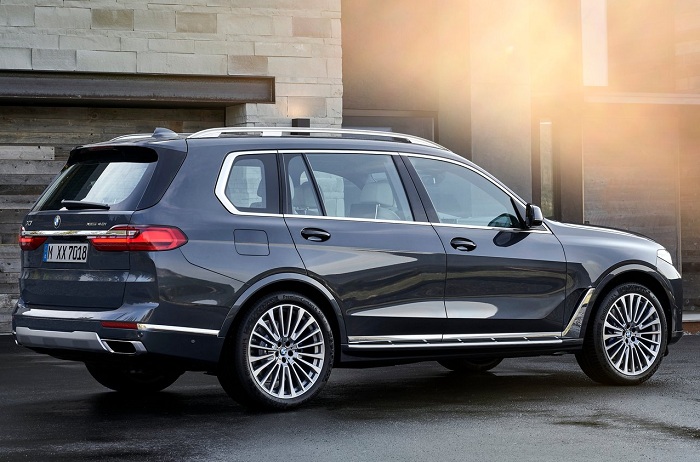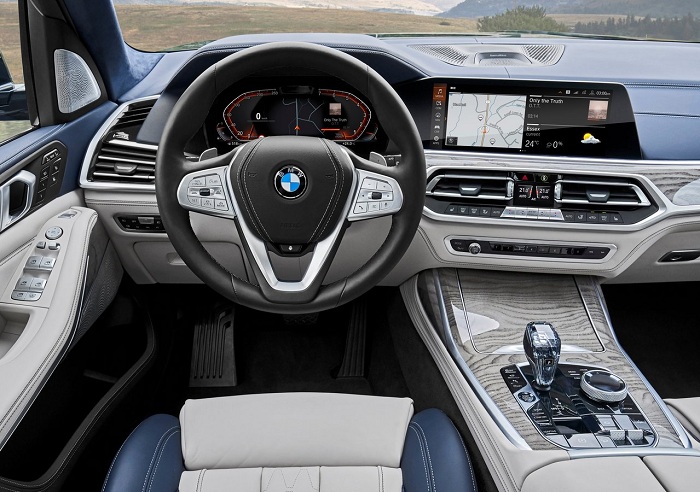A project first announced in 2014, and which bowed as the X7 iPerformance concept before the Frankfurt Motor Show last year, the X7, which will rival the Mercedes-Benz GLS, Audi Q7 and Range Rover and in the United States, the Cadillac Escalade and Lincoln Navigator, is claimed to “represent the next stage” of luxury for the Munch brand, as well as bringing added “visual poise, assurance and an overriding sense of authority”.
Underpinned by BMW’s CLAR platform as prior reports have stated, the X7 measures 5 151mm in overall length with a wheelbase of 3 105mm, height of 1 805mm and width of exactly 2 000mm, while riding on 20-inch alloy wheels as standard, though both 21 and 22-inch rollers are optional.
Only marginally toned down from the concept, the X7 sports the largest and widest take yet on the trademark kidney grilles, with other styling traits being the 7-series inspired aluminium sills running from the wheel arches down, slim LED headlights that can be fitted with Selective, Adaptive LEDs and Laserlights as options, rear doors that are larger and wider than fronts, and chrome detailing on nearly surface. At the rear, the X7 sports hints of the Navigator in the design, but comes with more chrome finishes, dual exhaust outlets and as with the X5, a split opening tailgate that is also electric.

Offered with a choice of two trim levels, the luxury focused Design Pure Excellence and the sportier M Sport, both bringing their own assortment of unique interior and exterior detailing, the X7’s cabin mirrors that of both the X5 and 8-series in overall design, with the tech fest kicking-off with the dual 12.3-inch digital instrument cluster and iDrive infotainment system, the latter featuring the brand’s new 7.0 operating system with ‘Hey BMW’ voice activation and updated Gesture Control.
The biggest departure from the X5, however, is the standard fitment of seven-seats, although buyers can also opt for the so-called captain’s chair arrangement for the second row, resulting in the X7 becoming a six-seater. Regardless of the arrangement selected, BMW claims a total boot space of 1 376-litres with all the seats up, and up to 2 560-litres with the second and third rows down.
Depending on the trim level, equipment on the X7 includes a three-part panoramic glass roof as standard, quad-zone climate control with a five-zone setup being optional, wireless smartphone charging, contoured LED interior ambient lighting, the BMW Digital Key, heated and cooled cupholders, and an optional Rear Entertainment system with dual 10.2-inch screens, two additional USB ports, an HDMI jack, wireless headphones and a Blu-Ray compatible DVD player.
While the sound system consists out of a 10-speaker setup as standard, buyers can gravitate towards a 16-speaker Harman Kardon or the flagship 1 500-watt Bowers & Wilkins Diamond Surround Sound System audio with 20-speakers.
Fitted as standard with BMW’s two-axle, self-levelling air suspension system with a further option being the four mode (xSnow, xGravel, xSand and xRocks) Off-Road package that premiered on the X5, the X7’s suite of safety and driver assistance tech consists out of Collision and Pedestrian Warning with City Braking, Traffic Jam Assist, Active Cruise Control, Lane Keeping Assistant, Parking Assistant Plus with Reversing Assistant, Lane Change Warning, Emergency Stop Assistant, Rear Collision Warning, Wrong-Way warning, Lane Departure Warning with Active Steeing and a 3D surround-view camera system.

Underneath its vast bonnet, the X7 will come powered by a choice of two turbocharged petrol engines and two turbodiesels, all connected to the now ubiquitous eight-speed Steptronic gearbox with standard xDrive all-wheel drive.
Displacing 3.0-litres, the xDrive40i serves as the petrol range’s entry-point with the blown straight-six producing 250kW/450Nm, allowing the X7 to complete the 0-100km/h sprint in 5.8 seconds before it tops out at 245km/h. For now the flagship petrol variant, the xDrive50i employs the same 4.4-litre bi-turbo V8 as the M850i and M5, although in this case, retuned to produce 340kW/650Nm. Limited to 250km/h, the 50i will still dispense with the benchmark acceleration time in 5.2 seconds.
On the diesel front, the xDrive30d comes with the same single-turbo 3.0-litre oil-burner as the X5, which makes 195kW/620Nm. In this guise, BMW claims a top speed of 227km/h and 0-100km/h in seven seconds.
Ending the range off, the M Sport infused M50d comes with the same engine as its sibling, but adds a further three turbocharges and the M Sport differential for a total power output of 294kW, with torque rated at 760Nm. While top speed is capped at 250km/h, the M50d will sprint from 0-100km/h in 5.4 seconds. No word was however made on the much speculated X7 M or M60i.
Like all other X models, production of the X7 will take place at BMW’s Spartanburg Plant in South Carolina, with sales kicking-off in March next year. BMW South Africa has since confirmed local availability of the X7 in the same month, although like the X5, buyers will be limited to the xDrive30d and M50d. Local pricing has also been revealed, with the former retailing from R1 562 849 and the latter from R1 862 308.
















